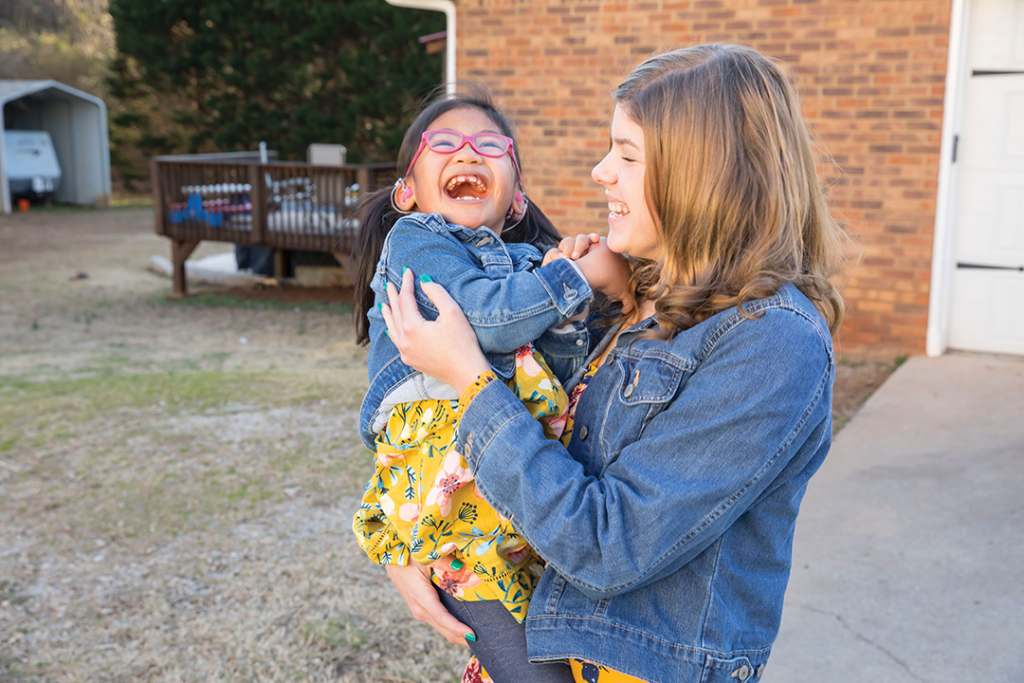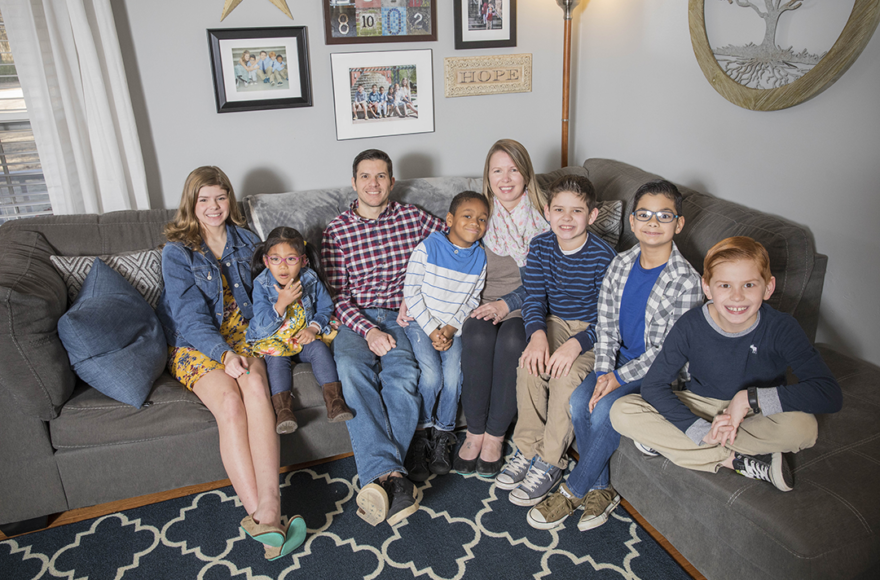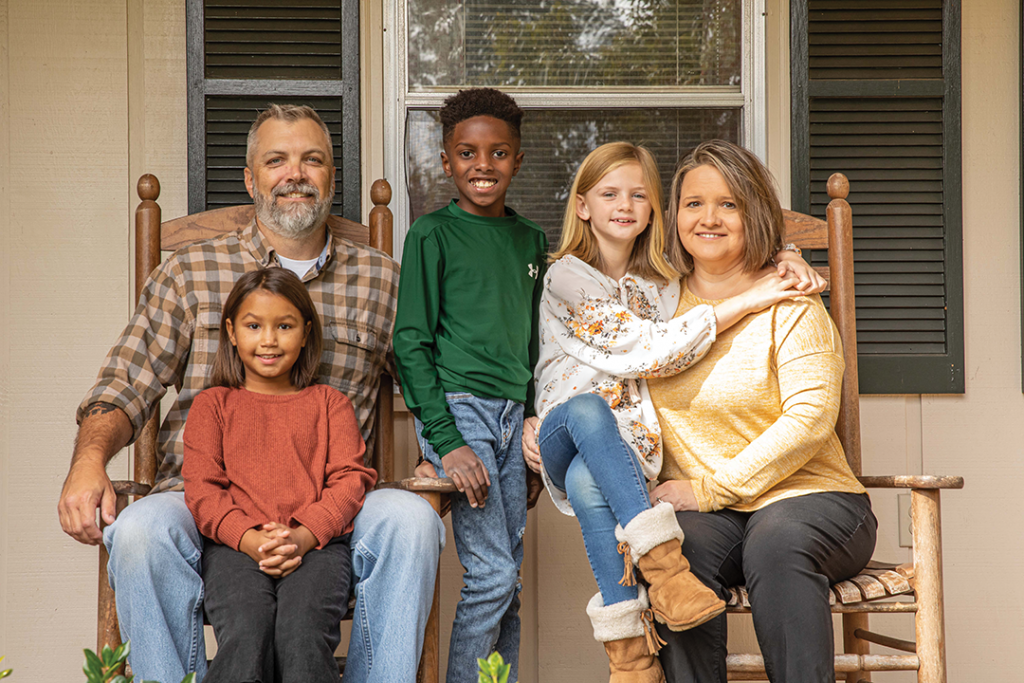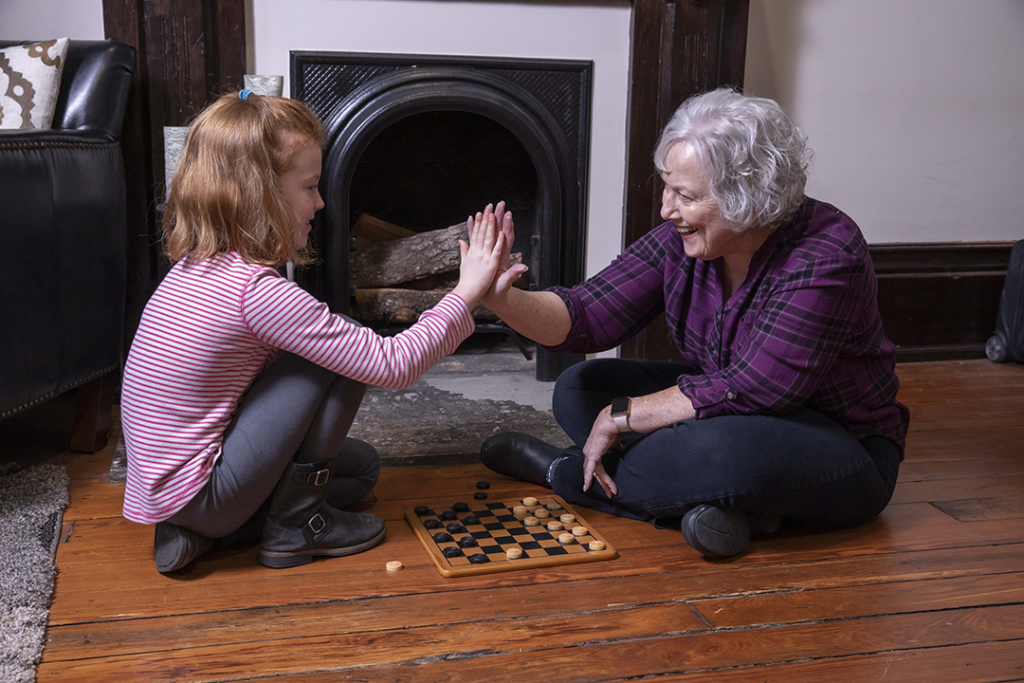Brice and Allison Hope have opened their home and hearts to more than 40 children through fostering and adoption.
Hope: a simple four-letter word carrying so much possibility, so much promise. “Hope anchors the soul,” penned the writer of the New Testament book of Hebrews. The verse is painted on a sign on the door to the Social Circle home of Brice and Allison Hope and their six children—three biological, Maddie, Ty and Jack, three fostered and adopted, Louie, Mia and Bryson. Theirs is a story rich in hope, doused with generous splashes of faith and love, endurance and resilience.
They met in college, Allison an incoming freshman, Brice a junior, at Atlanta Christian College, now Point University, in West Point. Both grew up in Gwinnett County, where they knew people in common and perhaps, without knowing, crossed paths. They dated and clicked, and though they were young, they talked about important subjects: faith, their futures and the family they hoped to have someday.

“Our first conversations were about kids and how many we were going to have,” Allison said, “and that I also wanted to adopt. I always knew I wanted to adopt.” Brice, focused heavily on mission work, was not even sure he wanted kids, but, as Allison said with a chuckle, “He came around.”
The Hopes married in August 2002 when both were in their early 20s. They attended a church where fostering was the norm, and just six months after marrying, they started training through their local Department of Family and Children Services office to become foster parents (the rules have since changed, as foster parents now have to be at least 25 years of age). Six months later they got two surprises.
“If you look throughout Scripture, God’s heart is always for the broken, the orphan, those who can’t take care of themselves. Brice and Allison live their convictions. That’s probably their greatest strength.”
Eastridge Church Pastor Scott Moore
“We found out we were pregnant with our oldest, Maddie, the same month we got our first foster placement,” Allison said. “We were fully vested in this little girl. We had her from 6 months until 18 months. She ended up going to live with relatives out of state. It broke our hearts. It was like the death of a child. We cried and grieved and were not prepared.”
However, the heartbreak did not stop them from taking in children for weeks, months, even years—like the 14-year-old boy from the youth group at the church where Brice was youth pastor. He had been kicked out of school, so DFCS let Brice take him to work with him each day to prepare for his GED. After three years with the Hopes, he moved back with his mom. It was not ideal, but by that point, “he got an experience of what a marriage looks like, what a family looks like,” Brice said, “and he got that GED.” The couple still sees him today.


Over time, the Hopes fostered 40 children, and while Brice and Allison still loved the mission of fostering, they were worn down by the administrative side, especially the bureaucracy and lack of accountability and transparency from DFCS. They needed a break. By this time, they had moved to Rockdale County. “I thought our family was complete,” Allison said. However, when their youngest son, Jack, was 3 years old, a presentation at church flipped the switch back on. Brice was at a Sunday morning service when a representative from the United Methodist Children’s Home, a Child Placing Agency with the State of Georgia, spoke about fostering.
“I don’t remember what was said,” Brice said, “because there was another sermon going on in my head. I didn’t want to [foster] again because I had a fear of getting hurt, all the heartache. At the end of the day, God essentially said, ‘So you’re not doing something because of your feelings being hurt,’ and that was it; and it wasn’t acceptable. We’re going to get banged up and bruised and damaged, but the goal of fostering is worth that. I came home and said, ‘This is where I’m at.’”
Allison still needed reassurance, but she found it during information meetings at UMCH. Because the private agency is much smaller, UMCH caseworkers have lighter caseloads, providing foster families more support than DFCS could.
“The agency eased my mind so much,” she said. “Communication and trust were there. It was a different experience.”
From Foster to Forever
Up to this point, the Hopes had only fostered children. Without knowing it, they were venturing into new territory, the journey of fostering to adoption beginning with a baby they named Bryson.
“We got Bryson when he was 2 days old,” Allison said. “I don’t know how we would ever have given that baby back if we’d had to because we went through some hard times with him.”
Bryson had to return to the hospital the day after he came home when he developed late-onset drug withdrawals. He stayed in the neonatal intensive care unit for several weeks, Brice and Allison never leaving him. Two months after bringing Bryson home, a text message came from their caseworker. Enter Louie: a little boy who had been in foster care since birth and had multiple failed adoptions. “We got one text, then another,” Allison said. “It was unexpected, but we said yes.” Louie led to their next child. At the time, Louie was non-verbal and thought to be autistic, and Allison felt it might help him to visit his previous foster home. When they arrived, they met another foster child living there. The little girl, Mia, was 2 years old and unable to sit up or roll over. She was tube-fed and would not allow anyone to touch her.

“She was left in a crib 24/7,” Allison said. “She had zero socialization. My heart ached for her from the moment I saw her. We had a connection. I had no intentions, but I loved her.”
Allison visited Mia regularly and noticed her health, already fragile because of Turner syndrome—a chromosomal condition affecting development in girls—was precarious. Alerting the authorities, Allison took her to the emergency room, where it was determined that Mia had not been properly cared for and fed. Eventually, the foster home was closed and the Hopes became her foster parents. Bryson and Louie were adopted a month apart from each other in 2014; Mia was adopted the following year. Because of the effects of Turner syndrome on her liver, Mia underwent a life-saving liver transplant in December 2017. The transplant journey was grueling but continued to cement the Hopes as a family. Though all three children have ongoing challenges to varying degrees, they are flourishing. The family in 2018 moved to Social Circle, where the children attend public school and participate in the typical flurry of activities.
“There are families who could have done what they did with one child and then said ‘that’s it’ and stopped,” said Denise Peacock, manager of foster home recruiting for UMCH. “They weren’t like that. Their greatest strength is that they are really committed to children needing a home. When we would call them, most times they would say ‘yes.’”
It is tempting to look at Brice and Allison as if they are special. They bristle at that type of talk. “I know I don’t have all my stuff together,” Brice said. “There’s always something I can improve, but you don’t have to have your stuff together to help a child.” Their friend Scott Moore, pastor of Eastridge Community Church, also fostered and adopted children. “If you look throughout Scripture, God’s heart is always for the broken, the orphan, those who can’t take care of themselves,” Moore said. “Brice and Allison live their convictions. That’s probably their greatest strength.”
Fostering and adoption are not for everyone, certainly, but it is inspiring to hear success stories.
“Those who succeed go into it knowing that there are a lot of unknowns, but these children still need homes and families regardless of the challenges,” Peacock said. “The Hopes are a perfect example of that.”
The Hope’s Top 3 Books on Adoption
- Adopted for Life by Russell Moore
- Fields of the Fatherless by Tom Davis
- The Connected Child by Karyn Purvis
Click here to read more stories by Patty Rasmussen.




